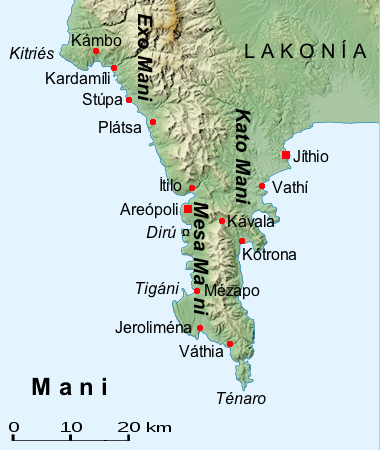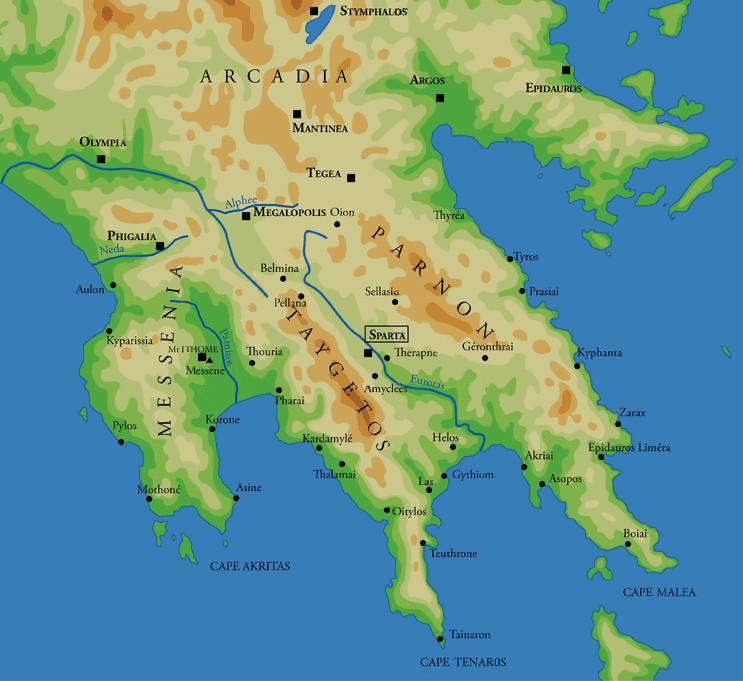|
Mani Peninsula
The Mani Peninsula ( el, Μάνη, Mánē), also long known by its medieval name Maina or Maïna (Μαΐνη), is a geographical and cultural region in Southern Greece that is home to the Maniots (Mανιάτες, ''Maniátes'' in Greek), who claim descent from the ancient Spartans. The capital city of Mani is Areopoli. Mani is the central peninsula of the three which extend southwards from the Peloponnese in southern Greece. To the east is the Laconian Gulf, to the west the Messenian Gulf. The Mani peninsula forms a continuation of the Taygetos mountain range, the western spine of the Peloponnese. Etymology The name "Mani" may come from the albanian word mani meaning mullbery Geography The terrain is mountainous and inaccessible. Until recent years many Mani villages could be reached only by sea. Today a narrow and winding road extends along the west coast from Kalamata to Areopoli, then south to Akrotainaro (the pointed cape, which is the southernmost point of contin ... [...More Info...] [...Related Items...] OR: [Wikipedia] [Google] [Baidu] |
Mani 2000
Mani may refer to: Geography * Maní, Casanare, a town and municipality in Casanare Department, Colombia * Mani, Chad, a town and sub-prefecture in Chad * Mani, Evros, a village in northeastern Greece * Mani, Karnataka, a village in Dakshina Kannada district of India * Mani, Iran, a village in Kerman Province, Iran * Mani, Nigeria, a town in Katsina State, Nigeria * Mani, Tibet, a village in the Tibet Autonomous Region of China * Maní, Yucatán, a small city in Yucatán, Mexico * East Mani, a municipality in the Laconia regional unit, Peloponnese, Greece * El Mani, a community on the island of Puerto Rico * Mani Peninsula, a geographical and cultural region in Greece * West Mani, a municipality in the Messenia regional unit, Peloponnese, Greece People * Mani (name), ( fa, مانی), a given name and surname (including a list of people with the name) ** Mani (prophet) (c. 216 – 274), an Iranian prophet ** Mani (musician) Gary "Mani" Mounfield (born 16 November ... [...More Info...] [...Related Items...] OR: [Wikipedia] [Google] [Baidu] |
Sminos
Sminos ( el, Σμήνος, before 2001: Σμύνος - ''Smynos'') is a former municipality in Laconia, Peloponnese, Greece. Since the 2011 local government reform it has been part of the municipality East Mani, of which it is a municipal unit. The municipal unit has an area of 94.503 km2. Population 1,192 (2011). It is located just north of the Mani Peninsula on the eastern slopes of Mt. Taygetos, and it is named after the river Smynos, that runs through it. The region is known as Vardounia (and its villages as Vardounochoria), after the medievaVardounia castlelocated in the area, now in ruins. Historically, Vardounia was a buffer zone between the Ottoman-Turkish controlled Evrotas plains and the Mani Peninsula. A contingent of Muslim Albanian settlers were relocated to the region by the Ottomans. These settlers formed a large segment of the local population until the Greek War of Independence when they fled to the Turkish stronghold at Tripoli. The seat of the municipal ... [...More Info...] [...Related Items...] OR: [Wikipedia] [Google] [Baidu] |
Byzantine Empire
The Byzantine Empire, also referred to as the Eastern Roman Empire or Byzantium, was the continuation of the Roman Empire primarily in its eastern provinces during Late Antiquity and the Middle Ages, when its capital city was Constantinople. It survived the fragmentation and fall of the Western Roman Empire in the 5th century AD and continued to exist for an additional thousand years until the fall of Constantinople to the Ottoman Empire in 1453. During most of its existence, the empire remained the most powerful economic, cultural, and military force in Europe. The terms "Byzantine Empire" and "Eastern Roman Empire" were coined after the end of the realm; its citizens continued to refer to their empire as the Roman Empire, and to themselves as Romans—a term which Greeks continued to use for themselves into Ottoman times. Although the Roman state continued and its traditions were maintained, modern historians prefer to differentiate the Byzantine Empire from Ancient Rome a ... [...More Info...] [...Related Items...] OR: [Wikipedia] [Google] [Baidu] |
Dorians
The Dorians (; el, Δωριεῖς, ''Dōrieîs'', singular , ''Dōrieús'') were one of the four major ethnic groups into which the Hellenes (or Greeks) of Classical Greece divided themselves (along with the Aeolians, Achaeans, and Ionians). They are almost always referred to as just "the Dorians", as they are called in the earliest literary mention of them in the '' Odyssey'', where they already can be found inhabiting the island of Crete. They were diverse in way of life and social organization, varying from the populous trade center of the city of Corinth, known for its ornate style in art and architecture, to the isolationist, military state of Sparta. And yet, all Hellenes knew which localities were Dorian, and which were not. Dorian states at war could more likely, but not always, count on the assistance of other Dorian states. Dorians were distinguished by the Doric Greek dialect and by characteristic social and historical traditions. In the 5th century BC, Dori ... [...More Info...] [...Related Items...] OR: [Wikipedia] [Google] [Baidu] |
Mycenaean Period
Mycenaean Greece (or the Mycenaean civilization) was the last phase of the Bronze Age in Ancient Greece, spanning the period from approximately 1750 to 1050 BC.. It represents the first advanced and distinctively Greek civilization in mainland Greece with its palatial states, urban organization, works of art, and writing system.Lazaridis, Iosif et al.Genetic origins of the Minoans and Mycenaeans. ''Nature'', 2017Supplementary Information "The Mycenaeans", pp. 2–3).. The Mycenaeans were mainland Greek peoples who were likely stimulated by their contact with insular Minoan Crete and other Mediterranean cultures to develop a more sophisticated sociopolitical culture of their own. The most prominent site was Mycenae, after which the culture of this era is named. Other centers of power that emerged included Pylos, Tiryns, Midea in the Peloponnese, Orchomenos, Thebes, Athens in Central Greece and Iolcos in Thessaly. Mycenaean settlements also appeared in Epirus, Macedonia, o ... [...More Info...] [...Related Items...] OR: [Wikipedia] [Google] [Baidu] |
Homer
Homer (; grc, Ὅμηρος , ''Hómēros'') (born ) was a Greek poet who is credited as the author of the ''Iliad'' and the ''Odyssey'', two epic poems that are foundational works of ancient Greek literature. Homer is considered one of the most revered and influential authors in history. Homer's ''Iliad'' centers on a quarrel between King Agamemnon and the warrior Achilles during the last year of the Trojan War. The ''Odyssey'' chronicles the ten-year journey of Odysseus, king of Ithaca, back to his home after the fall of Troy. The poems are in Homeric Greek, also known as Epic Greek, a literary language which shows a mixture of features of the Ionic and Aeolic dialects from different centuries; the predominant influence is Eastern Ionic. Most researchers believe that the poems were originally transmitted orally. Homer's epic poems shaped aspects of ancient Greek culture and education, fostering ideals of heroism, glory, and honor. To Plato, Homer was simply the one ... [...More Info...] [...Related Items...] OR: [Wikipedia] [Google] [Baidu] |
Neolithic
The Neolithic period, or New Stone Age, is an Old World archaeological period and the final division of the Stone Age. It saw the Neolithic Revolution, a wide-ranging set of developments that appear to have arisen independently in several parts of the world. This "Neolithic package" included the introduction of farming, domestication of animals, and change from a hunter-gatherer lifestyle to one of settlement. It began about 12,000 years ago when farming appeared in the Epipalaeolithic Near East, and later in other parts of the world. The Neolithic lasted in the Near East until the transitional period of the Chalcolithic (Copper Age) from about 6,500 years ago (4500 BC), marked by the development of metallurgy, leading up to the Bronze Age and Iron Age. In other places the Neolithic followed the Mesolithic (Middle Stone Age) and then lasted until later. In Ancient Egypt, the Neolithic lasted until the Protodynastic period, 3150 BC.Karin Sowada and Peter Grave. Egyp ... [...More Info...] [...Related Items...] OR: [Wikipedia] [Google] [Baidu] |
Homo Sapiens
Humans (''Homo sapiens'') are the most abundant and widespread species of primate, characterized by bipedalism and exceptional cognitive skills due to a large and complex brain. This has enabled the development of advanced tools, culture, and language. Humans are highly social and tend to live in complex social structures composed of many cooperating and competing groups, from families and kinship networks to political states. Social interactions between humans have established a wide variety of values, social norms, and rituals, which bolster human society. Its intelligence and its desire to understand and influence the environment and to explain and manipulate phenomena have motivated humanity's development of science, philosophy, mythology, religion, and other fields of study. Although some scientists equate the term ''humans'' with all members of the genus ''Homo'', in common usage, it generally refers to ''Homo sapiens'', the only extant member. Anatomically mod ... [...More Info...] [...Related Items...] OR: [Wikipedia] [Google] [Baidu] |
Gythio Peloponnisos
Gytheio ( el, Γύθειο, ) or Gythio, also the ancient Gythium or Gytheion ( grc, Γύθειον), is a town on the eastern shore of the Mani Peninsula, and a former municipality in Laconia, Peloponnese, Greece. Since the 2011 local government reform it is part of the municipality East Mani, of which it is a municipal unit. The municipal unit has an area of 197.313 km2. It was the seaport of Sparta, some north. Gytheio is the site of ancient Cranae, a tiny island where according to legend Paris of Troy and Helen from Sparta spent their first night together before departing for Troy, thus igniting the Trojan War. Gytheio used to be an important port until it was destroyed in 4th century AD, possibly by an earthquake. Even thereafter its strategic location gave Gytheio a significant role in Maniot history. Today it is the largest and most important town in Mani. It is also the seat of the municipality of East Mani. Historical population Geography Gytheio is ... [...More Info...] [...Related Items...] OR: [Wikipedia] [Google] [Baidu] |
Mani Flag (Greece)
Mani may refer to: Geography * Maní, Casanare, a town and municipality in Casanare Department, Colombia * Mani, Chad, a town and sub-prefecture in Chad * Mani, Evros, a village in northeastern Greece * Mani, Karnataka, a village in Dakshina Kannada district of India * Mani, Iran, a village in Kerman Province, Iran * Mani, Nigeria, a town in Katsina State, Nigeria * Mani, Tibet, a village in the Tibet Autonomous Region of China * Maní, Yucatán, a small city in Yucatán, Mexico * East Mani, a municipality in the Laconia regional unit, Peloponnese, Greece * El Mani, a community on the island of Puerto Rico * Mani Peninsula, a geographical and cultural region in Greece * West Mani, a municipality in the Messenia regional unit, Peloponnese, Greece People * Mani (name), ( fa, مانی), a given name and surname (including a list of people with the name) ** Mani (prophet) (c. 216 – 274), an Iranian prophet ** Mani (musician) Gary "Mani" Mounfield (born 16 November ... [...More Info...] [...Related Items...] OR: [Wikipedia] [Google] [Baidu] |


.jpg)
_-_Homer_and_his_Guide_(1874).jpg)


